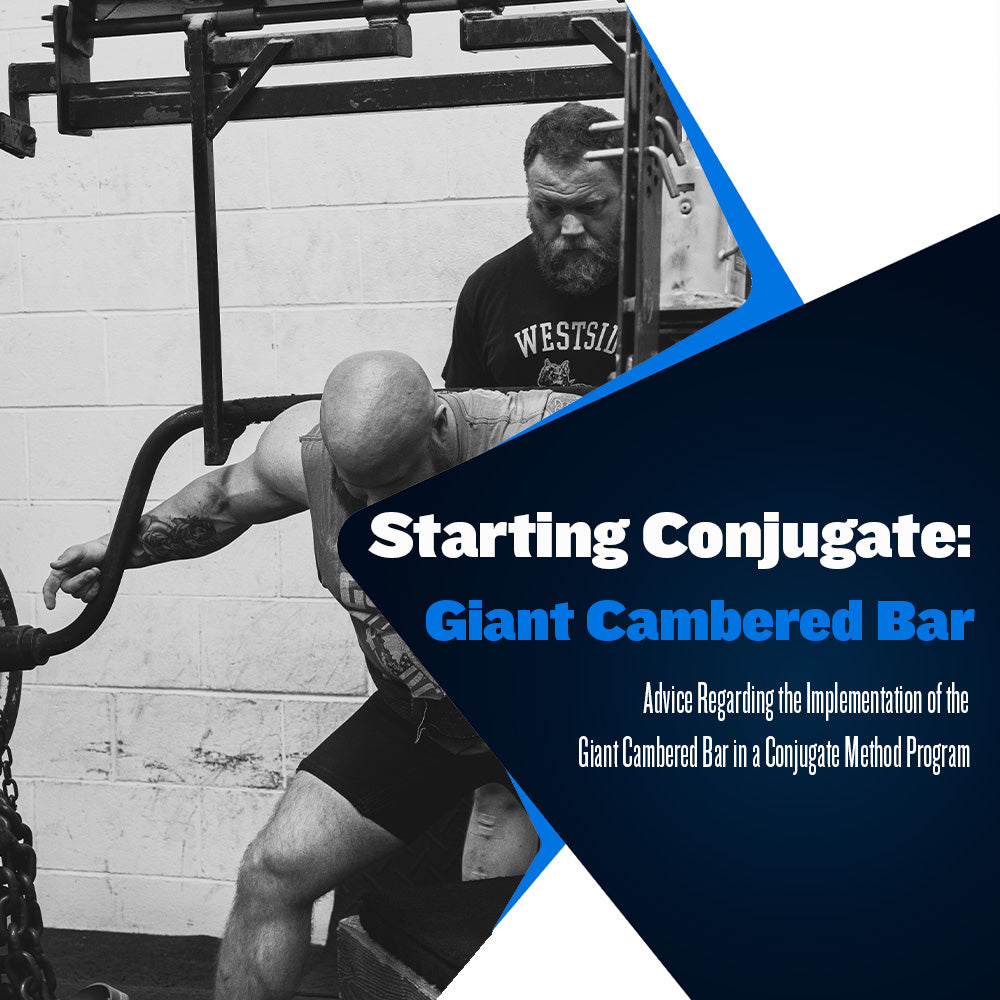Starting Conjugate: Giant Cambered Bar

The giant cambered bar is one of the most effective training tools a gym can have in its arsenal of specialty barbells. What makes this bar so valuable is its emphasis on the posterior chain, significantly improving the strength of the back, glutes, hamstrings, hips, and trunk. If you want to take your squats, deadlifts, jumps, and sprints to the next level, you should use the giant cambered bar for max effort, dynamic effort, and repetition effort work.
Additionally, the giant cambered bar is one of the best ways to improve an athlete's squat technique. This barbell is a great teacher of squat technique because it oscillates significantly when an athlete begins to lessen their control over the barbell. Unlike a typical squat bar, where you can become a bit lackadaisical and still save the lift, failure to maintain control over the giant cambered bar will quickly lead you to failure.
This barbell quickly helps to reveal your physical and technical squat weaknesses. A barbell that can provide this benefit is extremely useful, considering we need this data to optimize our lower body accessory exercise selections.
At Westside Barbell, we feature the giant cambered bar in our programming weekly. We use this barbell to target the posterior chain during our max, dynamic, and repetition effort training. This can manifest as max effort squats or good mornings, dynamic effort squats, or repetition effort work with squats and good mornings programmed as accessory exercises.
Here are some programming tips to help you get started with the giant cambered bar.
Max Effort
When we select the giant cambered bar for a max effort variation, we always perform either a squat or good morning. Regarding exercise selection, there are quite a few variations we can select. However, considering we are focusing on introducing the giant cambered bar into training, we will keep the initial exercise selection as simple as possible.
Here are the max effort exercises we recommend when using the giant cambered bar:
GCB Comp Squat
GCB Box Squat
GCB Good Mornings (No max singles, 3 rep max only)
GCB Anderson Squat
GCB Squat w/ Chains
As you begin using the giant cambered bar, you will want to stick with the comp squat, box squat, and good mornings. Once you get the hang of the barbell and its behavior throughout the lift, you can begin programming in advanced movements such as Anderson squats or squatting with chains added to the barbell.
Dynamic Effort
Dynamic effort squatting is where most will have difficulty with the giant cambered bar. To perform dynamic effort squats properly, we must move the barbell at a specific velocity. However, explosive movement with the giant cambered bar can cause the barbell to begin forcefully oscillating back and forth, throwing a lifter out of the groove and leading to missed lifts.
If we attach bands, we can reduce the forward and backward swing, but the bands can introduce some issues of their own when attached to the giant cambered bar. If you don't exert significant control over the barbell as you squat against the bands, you will experience shorter but more powerful oscillations due to the bands reacting to the swinging of the barbell. This can lead to failed reps or, worse, a dumped barbell.
We recommend allowing yourself to move slightly slower than usual when adding the giant cambered bar into your dynamic effort lower barbell rotation. Yes, this will have you moving at a less-than-optimal velocity. Still, it is crucial to master your ability to control the giant cambered bar before you attempt to move the barbell at increased velocities.
Repetition Effort
Using the giant cambered bar during your accessory movements is a great way to benefit the posterior chain muscles further. By incorporating hypertrophy-focused exercises that use the giant cambered bar, we can rapidly grow and strengthen the back, hamstrings, glutes, and hips.
Additionally, we will frequently perform our giant cambered bar accessory exercises beltless, leading to significant improvements in trunk strength and torso stability.
Here are the accessory exercises we recommend when using the giant cambered bar:
GCB Squat
GCB Low Box Squat
GCB Good Morning
GCB Anderson Squat
GCB Anderson Good Morning
Athletes will perform all the above exercises for 3-5 sets of 5-8 reps. Always match the bar weight to the set and rep scheme. We want to select the heaviest weight we can use while performing all sets and reps with proper form while leaving 1-2 reps in the tank each set.
The King of Specialty Barbells
The giant cambered bar is the most beneficial barbell for both strength and traditional sports athletes. Unfortunately, it is often the least-used barbell in many training facilities. No specialty barbell can match the giant cambered bar's training effect on the posterior chain.
You may find the giant cambered bar challenging to control at first. Do not let this deter you. Nearly every lifter struggles to maneuver this barbell their first few times using it, so expect some failed attempts. Just be sure to know your limitations and select your weights carefully as you become acclimated to how the giant cambered barbell behaves while in motion.
After a while, you will be able to control the barbell with no issues, and you will notice added pounds on your competition squat and deadlift. Once you move past the learning phase, this barbell will quickly become your preferred specialty barbell, and you will recognize the giant cambered bar as one of the most valuable training tools at your disposal.
Sources:
Simmons, L. (2007). Westside Barbell Book of Methods. Westside Barbell.
Verkhoshansky, Y., & Siff, M. C. (2009). Supertraining. Verkhoshansky.





